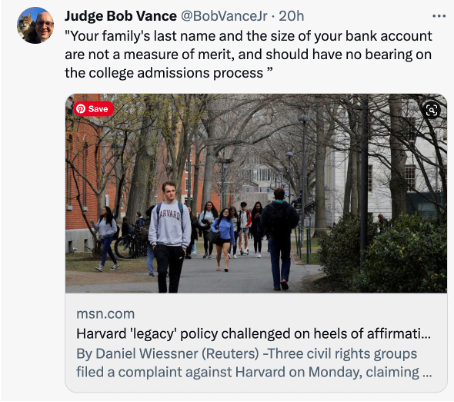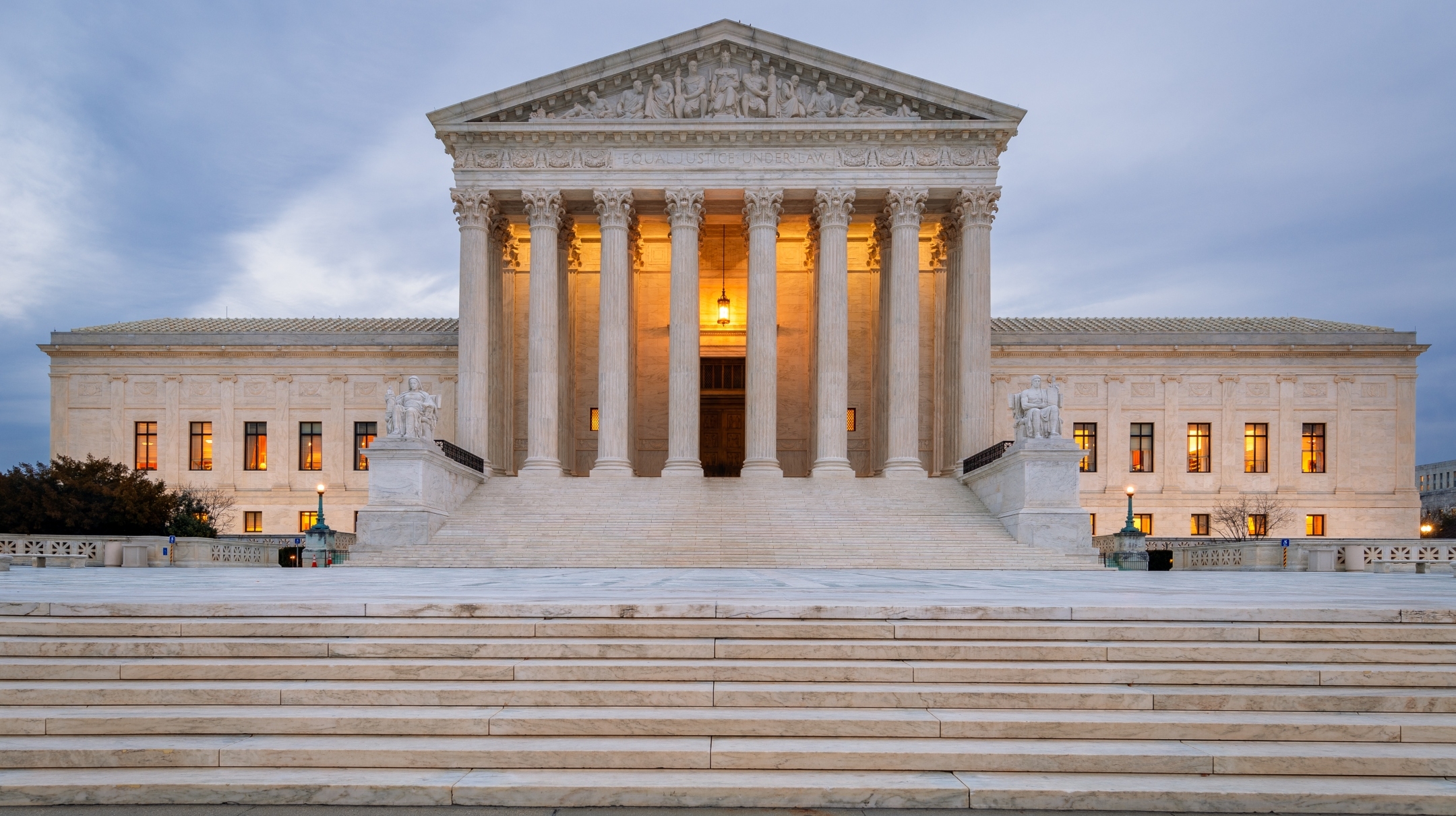It’s easy to understand why minority students would be up in arms over the Supreme Court’s decision to end affirmative action, while permitting practices like legacy-based admissions to continue. I am too. Our common sense tells us that giving college applicants a bump up in the process because they’re a “legacy,”—a parent attended the school they’re applying to—would largely serve to reinforce a system that historically served white, often wealthy, students.

This tweet is among the many reasons I adore my (Princeton/UVA educated) husband, who doesn’t have any problem calling out discrimination, unlike the conservative wing of the Supreme Court.
It didn’t take long for the group Lawyers for Civil Rights in Boston to swing into action after the Court decided the pair of cases, aimed at Harvard and the University of North Carolina that prohibited explicit consideration of race in the application process. A group of students have filed a complaint with the Department of Education, challenging Harvard’s use of legacy and donor status to give applicants a preference in admissions.
This is not a lawsuit filed in federal court, it’s a complaint filed with an executive branch agency. That was the right approach here, and it’s worth taking a moment to understand why, as challenges of this type begin to percolate. Why not just file a lawsuit in federal court?
The affirmative cases the Supreme Court just decided alleged Harvard and the University of North Carolina engaged in intentional discrimination, the affirmative use of race as criteria for admissions. Individuals are entitled to challenge intentional discrimination in court under Title VI of the Civil Rights Act and the Fourteenth Amendment. But challenges to legacy status, at least so far, aren’t about intentional discrimination. They’re “disparate impact” claims, which means they are objections to a law or practice has the effect of discrimination against certain protected groups, here, Black students and other minorities, regardless of the intent of the people who adopted the approach. We see disparate impact claims frequently in areas like employment and the adoption of laws and practices that make it difficult to vote or to register to vote.
Title VI of the Civil Rights Act prohibits recipients of federal financial assistance from discriminating based on race, color, or national origin both in and outside of the classroom. It applies to elementary, secondary, and postsecondary schools in all 50 states, the District of Columbia, Puerto Rico, and U.S. territories. But there’s a hitch. A 2001 Supreme Court case,
Alexander v. Sandoval, questioned whether there was any private right—whether individuals could file lawsuits like the plaintiffs in the affirmative action cases did on their own behalf—for disparate impact claims under Title VI.
Sandovalmeans that disparate impact claims like the ones here must be brought by a plaintiff like the Department of Education. So, bringing this complaint directly to the Department of Education is a first step towards officially teeing up the issue. It’s likely the Department will receive complaints from additional groups identifying additional institutions of higher education.
The Department of Education has an office that is specifically tasked with working on issues like this and filing lawsuits where appropriate, the Office for Civil Rights (OCR). For almost six decades, the OCR at Education, working with DOJ lawyers, has enforced Title VI the regulations that implement it. My experiences working with OCRs across federal agencies as the U.S. Attorney in North Alabama taught me that these folks are committed professionals. The OCR at Education has a demonstrated commitment to their mandate of ensuring equal opportunity for students who experience discrimination based on race, color, national origin, disability, age, and sex, including sexual orientation and gender identity. They work with a laser focus.
The Leadership Conference on Human and Civil Rights has been tracking statistics on preferential admissions that lay bare the disparate impact practices like legacy consideration result in:
· At Harvard, University of Pennsylvania, Dartmouth, Georgetown, Cornell, University of Southern California and the University of Virginia, legacies are “admitted at twice the rate of other applicants.
· The vast bulk of recruited athletes getting a leg up in admissions are in sports like crew, fencing, squash, and sailing, sports that aren’t offered at public high schools or available to most low-income students, particularly students of color. Student athletes are often admitted despite having weaker academic credentials than other students, with one analysis of 90,000 students at selective colleges and universities estimating that recruited athletes are as much as four times as likely to be admitted as other similarly qualified applicants.
· Many selective schools make big dollar donations a factor in admissions. Journalist Daniel Golden
reported that Harvard’s formal system for advancing children of its wealthiest donors, resulted in, “an astonishing enrollment rate of one child per major donor.”
· More than
43 percent of white students admitted to Harvard between 2009 and 2014 fell into four preferential categories: athletes, legacies (the children of alumni), the children of big donors or faculty and staff children.
· Alumni children are
up to eight times more likely to be accepted at elite colleges, according to one estimate. Another study at an unnamed elite Northeastern college found that so many legacy students had been admitted that they outnumbered the number of Hispanic students.
Just that sample of statistics should give us major concerns about equity in education. But the complaint brought by Lawyers for Civil Rights gives me some optimism for the future here. Affirmative action in education acted, in many ways, as a buffer to the advantage given to white students by historical discrimination and its reinforcement by consideration of legacy, donor, staff and athlete status (not many kids in my East Los Angeles high school had access to elite sports like crew or gymnastics). Now that affirmative action is gone, it’s time for a raw conversation about the lasting impact of historic discrimination in education. If Florida Governor Ron DeSantis has been upset about the use of critical race theory to explain discrimination in the legal system, just think about how this is going to set him off!
It’s easy to understand why minority students would be up in arms over the Supreme Court’s decision to end affirmative action, while permitting practices like legacy-based admissions to continue. I am too. Our common sense tells us that giving college applicants a bump up in the process because...

joycevance.substack.com

 www.goodnewsnetwork.org
www.goodnewsnetwork.org

 www.commondreams.org
www.commondreams.org





